The Great Savage Sword Re-Read: Vol. 1
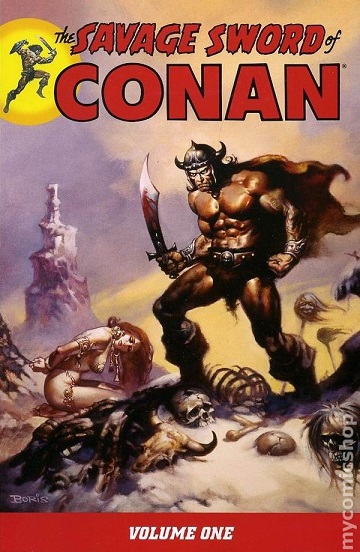
The Savage Sword of Conan is arguably the single greatest publication the Sword and Sorcery genre has ever seen. Spawned by the massive popularity of Marvel’s Conan the Barbarian color comic which launched in 1970, Savage Sword was a black-and-white Marvel Magazine whose first issue appeared in 1974.
The new format freed creators from the restrictions of the Comics Code Authority, which constrained Conan’s full-color adventures to all-ages entertainment. The violence, gore, and lurid themes of Robert E. Howard’s original Conan tales would no longer be censored by enforced comic-book morality. Now readers of the Cimmerian’s adventures would get to know the real Conan and the real Hyborian Age — in all their blood-spattered, head-lopping, breast-heaving glory.
I was 8 years old when I bought my first issue.
It was early 1978 and my family had just moved from Fort Knox to Elizabethtown, Kentucky. Moving to that neighborhood changed my life for many reasons, but one of the most significant was the presence of the Blue Bird Foodmart at the bottom of the hill. For the first 7 years of my life I was a small-town kid who only got exposed to comics when my parents/grandparents took me to a store somewhere. Now I could walk down the hill to a store that sold comics, magazines, and novels. The problem was that as an 8-year-old comics fan I had barely any money to spend on all those great books.
On that day in ’78, I could have chosen the latest issue of Creepy, Eerie, Heavy Metal, or any number of Marvel or DC comics. But it was Savage Sword of Conan #28 that caught my eye. Comics went for 35 cents apiece in those days, but here was an extra-thick “comic” with an amazing Earl Norem painted cover. For one whole dollar, it offered four times as many pages and featured the most realistic sword-fights and battles I had ever seen, complete with beheadings, guttings, and stabs in the back. The interior art was by John Buscema and Alfredo Alcala, a legendary penciller-inker team, and I had never seen anything like it.
Needless to say, it blew my little mind and left me hungry for more tales of Conan…
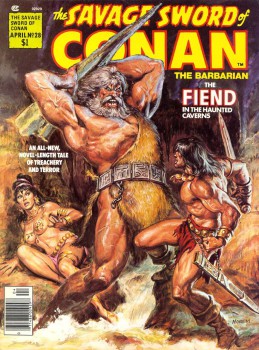
Not only did Savage Sword send me straight toward the prose stories of Robert E. Howard, it also sent me toward the Conan the Barbarian color comic. While I enjoyed both the Conan comic and the magazine, it was always the magazine that delivered the most bang for my buck. The violence was shocking, and the occasional nudity was a bonus — although I wasn’t quite old enough to be girl-crazy yet, so I mostly focused on the sword fights, the monsters, and the indomitable character of Conan himself. Every bloodthirsty foe his sword cut down was a childhood bully vanquished.
I still have a pile of Savage Sword issues left over from my youth. Although I quit reading comics for the duration of high school, I hung onto these mags. I still have my original copy of #28. That issue sent me searching for back issues — which I would occasionally find coverless or in rough shape. I didn’t care as long as I could read the stories. Collecting the entire run of Savage Sword would be impossible unless you have a giant bag of disposable cash. So when I heard back in ’06 that Dark Horse Comics was going to collect and reprint the entire run of Savage Sword, I was over the moon. I snapped up the first collection on the day it hit comic shops in 2007. Every few months since then, DH has released a new volume with the goal of reprinting all 235 issues of Savage Sword. The first ten years of the title’s run (’74 – ’84) is where the magic really happened.
The first volume of Dark Horse’s Savage Sword of Conan collections includes 15 issues’ worth of material and over 500 pages of classic sword-and-sorcery. Recently I decided to get out my first six volumes and read them straight through, since I didn’t always have time to do that over the last seven years. As I’m revisiting each collection, I thought I’d post my thoughts on the highs and lows of this immortal series.
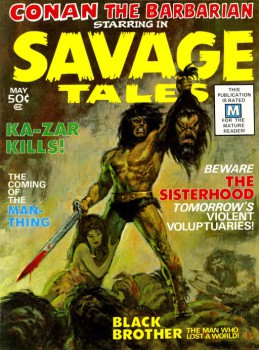
Volume One actually begins with Marvel’s Savage Tales black-and-white mag, which set the tone for what would become Savage Sword. These five issues feature superb work by writer Roy Thomas and iconic artists such as John Buscema, Barry Windsor-Smith, Jim Starlin, Gil Kane, Neal Adams, and Pablo Marcos. There’s nothing quite like Buscema’s Savage Tales #1 cover, on which a snarling Conan displays the severed head of his conquered foe. Buscema didn’t paint very often, but this cover is a pure Sword-and-Sorcery masterpiece. It sets the tone for the coming Age of Savage Sword.
These early “formative” tales from ST include superb adaptations of REH’s “Frost Giant’s Daughter” and “Red Nails,” as well as several other fine tales. Roy Thomas had already proven himself the best there is at adapting Howard’s tales into comics, and he wasn’t about to stop there. In fact, the best was yet to come. In addition to the Savage Tales issues, this inaugural Dark Horse collection includes Savage Sword of Conan issues #1 – 10.
“Big John” Buscema is, without a doubt, the mega-star of Savage Sword. His spectacular pencils kick off the first issue with inks by Pablo Marcos, but in the next issue he teams up with the great inker Alfredo Alcala — a match made in Hyborian Heaven. Savage Sword #2 with its legendary Neal Adams cover features Thomas, Buscema, and Alcala’s adaptation of Howard’s “Black Colossus.” It’s this second issue that sews the seeds of the true greatness that was to follow. Alcala’s highly rendered inks bring Buscema’s pencils to life with deep, lush linework that is heavy with shadow.
Together these two artists create an immersively gorgeous experience. For the first time, you don’t miss the color at all. This is black-and-white art meant to be seen in black-and-white, just as film directors from the age before Technicolor used black, white, and shades of grey to create a sophisticated palette of depth, texture, and emotion. The work of Buscema and Alcala on Savage Sword over the next few years would rise to a level of excellence that rivals all others. They brought the Hyborian Age to life and made it seem as real as the house next door. That is, if the house next door were full of barbaric swordsmen, creeping monstrosities, and marauding tribesmen.
Jim Starlin takes over the art chores for Savage Sword #3, and Tony DeZuniga (destined to become another one of Buscema’s best inkers in future volumes) also contributes a story. In issue #4, the Buscema-Alcala team returns for a savagely gorgeous adaptation of Howard’s “Iron Shadows in the Moon.” But readers hadn’t seen nothin’ yet.
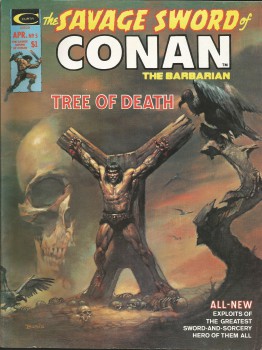
Issue #5 is a tour-de-force wherein Thomas and Buscema adapt Howard’s “A Witch Shall Be Born” with the help of several inkers collectively known as “The Tribe” (and the stellar work of DeZuniga is very obvious here). The haunting cover painting by Boris Vallejo depicts the most infamous Conan scene of all: Conan’s crucifixion. This was such a powerful element of Conan’s origin that John Milius and Oliver Stone made sure to include it in their screenplay to 1982’s Conan the Barbarian film. In the movie it’s Thulsa Doom who crucifies Conan, instead of the scheming Constantius in Howard’s story.
I’ve never seen any articles dealing with the concept of “Conan as Christ-figure,” but what else can you think about during a crucifixion scene? Conan’s definitely not a Christian — he lives by an honor code but he rarely forgives his enemies — and instead of turning the other cheek he’s as likely to split your skull. But then again crucifixion was not a punishment reserved for Jesus Christ alone — thousands of people were nailed to crosses by the Romans. It’s nearly certain that many of them were northern-bred barbarians similar to Conan himself. Robert E. Howard was a student of history, and he used it well to build his swashbuckling fantasies.
Later SS #5 was colorized for reprinting in a giant Treasury-Sized Edition by Marvel Comics. Reading that version you can see that the colorization wasn’t really necessary — Savage Sword was a black-and-white experience by intention, by design, and to startling effect. Issue #6 features tales from artists Sonny Trinidad and Alex Nino, but these feel like “holdover” tales until the magical team of Buscema/Alcala returns for “The Citadel at the Center of Time” in issue #7. Roy Thomas puts a unique spin on Conan here by introducing a wizard who travels through time. Again, the art is absolutely superb. Rumor has it that Buscema didn’t care for Alcala’s highly-rendered inking, but the results were stupendous for readers. Together the two men manifested a real synergy, creating something far greater than either artist could create on his own.
In issue #8 the great Tim Conrad (well-known for his work adapting Howard’s Almuric a few years later in the pages of Epic magazine) contributes art for “The Forever Phial.” In that same issue “Corsairs Against Stygia” features art by Gil Kane and Yong Montano. “Corsairs” is problematic as it seems to be a chapter from the middle of Howard’s novel Hour of the Dragon, a.k.a. Conan the Conqueror. I’m not sure why this novel adaptation didn’t start at the beginning of the novel, but issue #10 picks up where #8 left off — continuing this partial adaptation of the only Conan novel — with Buscema’s pencils inked once more by The Tribe.
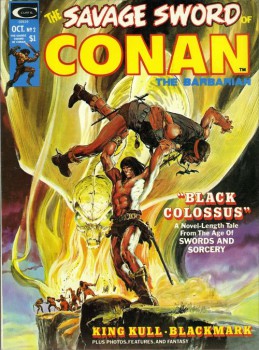
I believe the chapters that didn’t appear in Savage Sword ran in the color Giant-Sized Conan comic book, but it’s a pity they didn’t appear all together in the same place. As it stands, Savage Sword #8 and #10 are significantly hampered by this failure to tell the whole story, as well as appearing in non-sequential issues. Issue #9 is thankfully free of this flawed-yet-lovely adaptation, as it features Pablo Marcos doing both pencils and inks for “The Curse of the Cat-Goddess.” It’s also proof that Marcos’ true power lay in his inking ability; his pencils don’t quite stand up to those of John Buscema. But few artists ever do.
Overall, the three issues illustrated by Buscema/Alcala (#7, #9, and #12) set the bar incredibly high for Savage Sword going forward. In future issues this duo would go on to cement their status as one of the greatest penciller/inker teams of all time. (Volume #2 of the collected Savage Sword features no less than 10 tales illustrated by the Buscema/Alcala team.) They were truly the “rock stars” of the magazine’s early years. Over the next ten years, Buscema’s pencils would find other artistic soul-mates such as Tony DeZuniga and Ernie Chan, but it’s hard to beat the Buscema/Alcala chemistry.
There are two great reasons to get yourself a copy of The Savage Sword of Conan Vol. 1: Firstly, you get to watch the glorious formation of what would become the greatest sword-and-sorcery mag in comics history — and there is some terrific work to enjoy here. Secondly, you get to see the genesis of the amazing Buscema/Alcala art team. Those three issues alone are worth the price of the first volume.
In the next installment of this series I’ll examine Savage Sword Vol. 2, wherein the creators kick into high gear and really begin to take advantage of the magazine’s adult format. Expect more graphic violence, more gore, and more mature content.
‘Cause this ain’t comic books — it’s Sword and Sorcery.
Praise Crom.
Read Part II here.
John R. Fultz is the author of several novels including THE TESTAMENT OF TALL EAGLE and the Shaper Trilogy: SEVEN PRINCES, SEVEN KINGS, and SEVEN SORCERERS. His website is www.johnrfultz.com
[…] at BlackGate.com I’ve posted the first in a series of articles exploring/celebrating the SAVAGE SWORD OF […]
John,
I had piles of those and read them to shreds. I did eagerly buy that omnibus when it came out also. Lots of other magazine format choices too. Luckily they made a “Classic” sub-print that re-printed the earlier works, both savage sword and Barry Windsor Smith art era Conan – I loved the crossover with Elric the best and the “Living Tarim” saga.
I terribly miss the Warren era – I saw the last gasp of it as a young kid – the Creepy “Ressurection” issue that I think was the last proved to be one of my favorites.
Later I had to look for used copies and found lots of stuff that I’d missed – my real favorite is discovering “Ghita of Alizar” – Frank Throne was a bit P.O.’d when Marvel cancelled Red Sonja and so he moved to Warren publications for the 1984/1994 magazine run and he made something that he could use the sex and violence he could only hint at in Marvel – no magic chastity belt to keep the comics code stamp.
However, it was Marvel’s Conan mag that more or less started and kept this market going.
Marvel kept Savage Sword going for a long long long time – leading in part to that Discworld Cohen parody – but most of the rest of it seems to have dissappeared with Warren publishing going under – still too reliant on retailers then so possibly when Warren dropped they probably thought it all was cancelled.
Yes, GHITA OF ALIZAR is a true classic. I collected it a few years ago, after having been exposed to it in pieces in my younger years–thanks to the magazine called 1994–but I had never read the entire saga until a few years back. Definitely Thorne’s masterpiece.
I still have an almost complete run of Savage Sword, along with the color Conan the Barbarian series. Years ago, I tried to put each series together in chronological order. For the most part I succeeded, but abandoned the project for some reason.
These black and white issues are still some of my all-time favorites to re-visit. John Buscema’s pencils are absolutely stunning. They just exude power. No current artist has been able to capture that sense of dynamism, which makes these issues all the more special, by Crom!
Personally I think Buscema+Alcala was an impressive yet often awkward mix.
I think Alcala’s solo work on Voltar is much finer (but harder to come across). Magic Carpet: Voltar is the only English version I know of but the imminent Art Of Alfredo Alcala promises to have lots of Voltar art in it.
http://www.alanguilan.com/museum/alfredo8.html
http://www.alanguilan.com/museum/alfredo14.html
http://www.alanguilan.com/museum/alfredo15.html
http://alcalalegacymilestoneofthemaster.blogspot.co.uk/2009/03/alcala-legacy-excalibvr-justice.html
I highly recommend the volumes for all the Conan fans too. John–well done.
Also, after reading Tall Eagle I’m going to have to post a review on Goodreads and then start reading Seven Princes.
It is a shame that the Savage Sword of Conan series died but it was something I looked forward to each and every month.
Thanks, Wild Ape! I much appreciate it…
Wow! You know, I only recently started collecting these, and just prior to them going out of print, it seems. I was delighted when volume 20, which I had on pre-order, appeared on my doorstep the other day. Roy Thomas was gone for long years, but turned back up in volume 18 and then wrote through the end of the series.
But there are occasional strong yarns from others in between.
Anyway, I look forward to reading along with your evaluations, because all of this is very, very fresh for me! Grand stuff. I’ve discovered that I enjoy a good Roy Thomas pastiche Conan story better than 4/5 of other sword-and-sorcery, especially of the Clonan knock-offs.
Hey, Howard! Yes, these collections are some of the very best comics ever done–John Buscema was the shining star of the series–along with his amazing inkers beginning with Alfredo Alcala, then later the amazing Tony DeZuniga and Ernie Chan (who also made a name for himself inking Buscema on the color Conan comic). I really can’t recommend the first 6 volumes enough–they’re THAT good. Sometimes I’m reading an issue and I’m just gobsmacked by the quality of the illustration. Of course, there are always a few issues where it’s a little “off”–but those are usually the issues where guest artists came in. And sometimes those guests did great work too. But if there’s one place where the Buscema Legacy towers like Mt. Fuji, it’s in the pages of SAVAGE SWORD.
Yes, when Roy Thomas left the book had to “find itself” again…and later when Buscema left for awhile Ernie Chan took up the mantle and started pencilin AND inking. But Buscema — who didn’t like drawing superheroes — always seemed to return to Conan. And even in the later half of its existence, when the mag had lost some of it’s original glory, there were still runs that were exceptional. I look forward to discovering and re-discovering those as I continue to read through (and write about) the series.
Oh–and those rare issues where Buscema inked himself? Glorious…
I think my “ideal Conan” is the Buscema/DeZuniga version. (Topped only by Frazetta’s version from the paperback covers.)